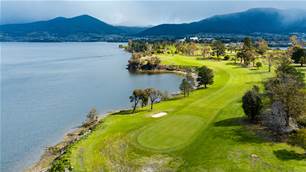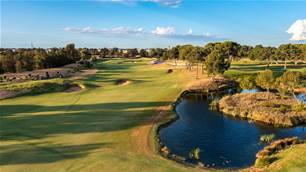With cost-of-living pressures being what they are at the moment, you don’t need to avoid the golf course to save your pennies.
MALENY GC
Maleny, Queensland
Green fee: $42.50 (seven days).
Designed by renowned architect Graham Papworth and inspired by the origins of the game in Scotland – covers about 25 percent of the Maleny Community Precinct, with the remaining land being devoted to other sports as well as heritage, walking paths, rainforest and wetlands.
The par-68 course was built in stages – at an amazing cost of $1.6 million – with the first nine opening for play in 2015 and the remaining holes officially hosting rounds in early 2020.
Maleny opens with a cracking par-3. The 136-metre gem is played from an elevated tee over a deep gully to an angled green, which slopes markedly from right-to-left. The green is actually terraced into a hillside and a rock wall beneath the low side of the putting surface creates a steep drop-off and any ball finishing at the base of the wall will leave an almost impossible recovery shot. Not long after the full 18 holes opened for play, Adam Scott played the course and made a double bogey five at the first, en route to setting the course record of 62.

HERVEY BAY G&CC
Hervey Bay, Queensland
Green fee: $41 (seven days).
Golf has been played at Hervey Bay since 1945 but it wasn’t until the laste 1970s that the layout was expanded to 18 holes and its reputation as the finest course on Queensland’s Fraser Coast.
In recent times, the club has begun a program of green and bunker renovations, with noted deisgner Richard Chamberlain crafting the new green complexes.
The 295-metre par-4 8th was the first to undergo change with the green more than doubled in size and the surrounds given more definition with mounds and hollows as well as a deep greenside bunker. The new green opened four months ago and the Tifeagle surface is already beautifully smooth and rolling at a good speed, while the TifTuf surrounds provide a tight surface that offer a wide range of chipping options.

CAPEL GC
Stratham, Western Australia
Green fees: $40 (Mondays); $50 (Tues-Sun).
Blink and you might just miss it. Driving along the Bussell Highway, about 20 minites’ drive south of Bunbury, it is easy to miss the turn into the Capel course, which could prove disastrous for golfers as this is one of the best conditioned layouts outside of Perth.
It is also an easy walking par-72 layout, with relatively wide, nicely manciured fairways gently rolling between the thickly tree-lined edges. The subtle breaking greens are also generous in size.
All but three holes laid out predominantly north-east to south-west, which adds to the challenge of making a good score here as the ocean breezes blow across your playing line more often than not.
COOROY GC
Cooroy, Queensland
Green fee: $40 (seven days).
Cooroy Golf Clib is a hidden gem in the heart of the rolling valleys of the Noosa hinterland, about 25 minutes’ drive west of Noosa Heads.
What the course lacks in length (5,359 metres from the back markers) it more than makes up for in interesting holes as it plays nine holes out and nine back.
One of those holes is short par-4 9th alongside two lakes to the left is a narrow, but exciting, journey from tee to green, while the following hole, a 164-metre par-3, plays along the edge of the aforementioned lake in the opposite direction. It features a narrow green with a long ‘coffin-style’ bunker left.

GISBORNE GC
Gisborne, Victoria
Green fees: $40 (weekdays); $45 (weekends).
Gisborne is widely regarded as the best course in the Mt Macedon Ranges region, about 40 minutes’ drive north west of Melbourne’s outskirts.
Designed by Vern Morcom in the late 1940s, much of his original work remains with only slightly alterations made at various times during recent decades.
Gisborne is typical of Morcom’s work –
no two holes present the same and the risk-reward elements dominate throughout.
And if that’s not enough to entice, there’s always the challenge of the tee shot on the par-3 16th across a lake to a heavily-bunkered green with Mt Macedon looming on high in the background.

HIDDEN VALLEY RESORT
Wallan, Victoria
Green fees: $40 (weekdays); $50 (weekends)
Located less than 60 minutes’ drive from Melbourne’s CBD, Hidden Valley is set on 450 acres of rolling land surrounded by picturesque Victorian countryside.
The presentation of the par-73 layout has improved significantly in recent years, so it now complements the quality of Craig Parry’s design, which presents some interesting challenges during a round.
But, perhaps, the most interesting of all is left until last. The par-3 18th – with tees offering shots from 112 metres through to 166 at the very back – demands a full water carry to an island green where the putting surface lies beyond three bunkers. Once you have hit the green here, make the walk across the bridge with your putter in hand.
LAKES ENTRANCE GC
Lakes Entrance, Victoria
Green fee: $40 (seven days).
Lakes Entrance covers a wonderful sandy landscape with high dunes the only thing separating it from the beach and the waters of Bass Strait.
When the club moved to its current site in 1958, the land was a combination of swamp and undulating sand ridges covered with coastal banksias, wattle and ti-tree – the perfect land for a natural links.
The legendary designer Vern Morcom laid out the 18 holes simply by walking the land and driving pegs into the ground to mark the location of tees and greens.
The front nine runs closest to the beach and covers rolling terrain with several tees elevated on dunes to offer ocean views. Argubaly the best of these holes is the 418-metre par-4 7th, which follows the direction of dunes to the right and doglegs left around a pond that lies on the inside corner of the fairway. On final approach to the green, the fairway narrows dramatically between the ti-tree and the locals have dubbed this part of the hole “The Khyber Pass” because it is tight and treacherous.

LEURA GC
Leura, New South Wales
Green fees: $40 (weekdays); $50 (weekends).
Leura has had a reputation for being a fine layout dating back more than a century.
The original nine holes were designed by Carnegie Clark in 1904 before overseeing the extension to 18 holes 20 years later. Part of that build included the introduction of bentgrass greens, giving Leura the distinction of being the first Australian course to have the pure putting surface.
Be sure to have your phone handy for a photo beside Leura’s 14th hole where the green is positioned just metres away from clifftops overlooking the majestic Jamison Valley.
LOXTON GC
Loxton, South Australia
Green fee: $40 (seven days).
The Loxton Golf Club was formed nearly a century ago but it wasn’t until the mid 1970s that it took a great leap towards becoming the best layout in the Riverland region.
After a major tree-planting program that saw eucalypts, casuarinas, melaleucas, bottlebrushes, wattles as well as Aleppo and Canary Island pines scattered around the course, all greens were converted to bentgrass and have flourished ever since. As have the very good couch fairways.
MARYBOROUGH GC
Maryborough, Queensland
Green fee: $40(seven days).
If you haven’t played golf on Queensland’s Fraser Coast you may not have heard of this golfing gem.
To give you an idea of the quality of the layout, it was originally designed in 1927 by Scottish expat Dan Soutar, who also has Kingston Heath on his architecture resume. While the course was upgraded in the mid-1980s, the bones of Soutar’s work remain.
The terrain varies from relatively flat to some interesting natural rolling topography towards the end of the round.

MT GAMBIER GC
Mt Gambier, South Australia
Green fee: $40 (seven days).
Located halfway between Melbourne and Adelaide, Mt Gambier has gained a reputation for the best presented layout on South Australia’s Limestone Coast.
Recent upgrades to the agronomy and design tweaks under the guidance of Neil Crafter and Paul Mogford (Golf Strategies) in recent times have really enhanced that standing.
Mt Gambier boasts plenty of testing holes where the elevation change, from tee-to-green combined with a dogleg to make for a challenging shot-making experience from an uneven lie.
For example, the slightly uphill 500-metre par-5 7th offers a wide fairway but the ideal playing line from tee is to the right side before laying up to the left half of the short grass, to safely avoid bunkers short right of the small green.
NARACOORTE GC
Naracoorte, South Australia
Green fee: $40 (seven days).
Naracoorte’s par-72 layout was carved out of wild, thick scrub, wattles and bracken more than 90 years ago and today it is one of the prettiest courses in regional South Australia.
The course lies across beautiful rolling terrain and the deep sandy base beneath its fairways ensures the layout is playable year-round, while the bunkering is natural and easily maintained.
In fact, there are elements of the design and set-up of the course – like putting surfaces cut right to the lip of bunkers – that have obviously been influenced by the design of the great Melbourne Sandbelt courses.

RATHO FARM
Bothwell, Tasmania
Green fee: $40 (seven days).
Ratho is the birthplace of Australian golf. The nation’s oldest course, just a few minutes’ drive from small town of Bothwell, dates back to 1822 when Scot, Alexander Reid, played on Ratho with featheries and clubs brought from the home country.
Three generations of Reids followed in their enjoyment of the links. The great-grandfather of Greg Ramsay purchased Ratho in 1936 and in recent years Ramsay has been working with course designers Neil Crafter and Paul Mogford to restore the course to its true origins.
www.rathofarm.com

ROBE CC
Robe, South Australia
Green fee: $40 (seven days)
Robe Golf Club was founded 98 years ago but it has only appeared on the radar of travelling golfers in the past few years, thanks to the creation of six new holes.
Course architects Neil Crafter and Paul Mogford (Golf Strategies) were commissioned to design six new holes west of the clubhouse and heading off into spectacular duneland behind West Beach.
The new holes follow the natural contouring of the dunes, along the coast. The par-4 7th plays directly to the west and the green lies in a natural amphitheatre among the dunes. Two radar huts from World War II, once secreted deep in the scrub-covered dunes, were restored and are a feature of the hole.
The short climb to the next tee slowly reveals a wonderful par-3, played across the top of a dune and usually into the teeth of the prevailing south-westerly, which brings a lone bunker front left of the putting surface into play.
Related Articles

60 Best Aussie metro courses you can play for $50 or less

International Spotlight: Omanu Golf Club













